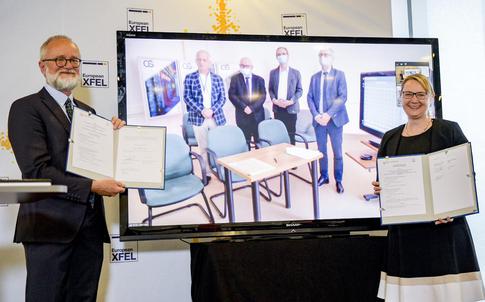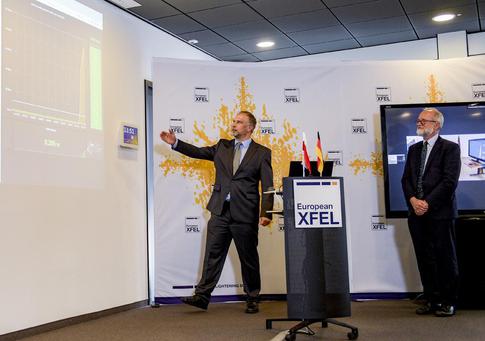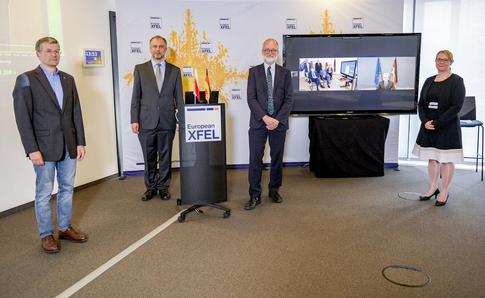XFEL: Ultra high-speed data connection to Poland opens
Ultra high-speed data connection to Poland opens

Robert Feidenhans'l (left) and Nicole Elleuche (right), Managing Directors of European XFEL, join Krzysztof Kurek (monitor), Director of NCBJ, to sign an agreement that paves the way to using NBCJ computing power to process data generated by experiments at European XFEL. Copright European XFEL
Tomorrow Poland and Germany are expected to open their borders for travel and tourism. The border has already opened for scientific data to travel at high speed in both directions. Today Secretary of State Wolf-Dieter Lukas of the German Federal Ministry of Education and Research, and the Polish Undersecretary of State of the Polish Ministry of Science and Higher Education Grzegorz Wrochna opened an ultra high-speed connection for the exchange of scientific data between the two countries.
The new connection between European XFEL, DESY and National Center for Nuclear Research (NCBJ) in Otwock-Świerk near Warsaw will be used to analyse data from experiments carried out by international teams of researchers at the world's largest X-ray laser European XFEL.
The first passenger on the new data line was data from the model biomolecule lysozyme, of which16 million frames of data were collected at European XFEL and analysed in a proof of concept experiment published in 2019. The data will now be analysed again in Poland to test and validate the software and procedures in situ at NCBJ.
X-ray data of molecules enable scientists to determine their three-dimensional structure. Many such images are combined to create molecular movies to investigate extremely fast processes, for example in the human body, in chemical reactions or in materials.

Robert Feidenhans'l (right) and Krzysztof Wrona (left) initiate the first transfer of scientific data from European XFEL, in Schenefeld near Hamburg, to Otwock-Świerk, near Warsaw. With this transfer the ultra high-speed connection for the exchange of scientific data between the two countries was opened. Copyright European XFEL
The new international connection will enable data to travel with a speed up to 100 gigabits per second (Gbit/s) – about 400 times faster than a standard household high-speed internet connection, which can typically manage a download speed of about 250 Mbit/s. It is approximately 100 times faster than the typical internet connections between European XFEL and other research institutes, with the exception of DESY. On a normal connection it would take about a month to transfer the huge amount of data generated by an average experiment at the facility. The new connection will reduce this to just a few hours.
Wolf-Dieter Lukas, Secretary of State at the German Federal Ministry of Education and Research said, “The ultra high-speed connection brings us closer together at a time when we need it most. Polish and German ingenuity, scientific and engineering excellence, great teamwork and significant investment have made this possible. Between Poland and Germany, we now have scientific instruments to observe extremely fast processes, computing centres to analyse them, and a data connection to transmit the data and the data and the results – all at high speed.”
“The fact that the second, next to Hamburg, XFEL laser data centre is being created at NCBJ is a huge success of Polish scientists. The Ministry and NCBJ have been preparing this undertaking for several years. This success is an expression of recognition of the European XFEL member countries for the Polish contribution to the construction, commissioning and XFEL support,” said Grzegorz Wrochna, Polish Undersecretary of State of the Polish Ministry of Science and Higher Education.

Representatives of the German Federal Ministry of Education and Research, the Polish Ministry of Science and Higher Education, European XFEL, the Polish National Center for Nuclear Research (NCBJ) and the Deutsches Elektronen-Synchrotron (DESY) participated in the opening of the ultra high-speed scientific data connection between Germany and Poland. From left to right: Wim Leemans from DESY, Krzysztof Wrona, Robert Feidenhans'l, and Nicole Elleuche from European XFEL. On the monitor: Grzegorz Wrochna from the Polish Ministry of Science and Higher Education, as well as Krzysztof Kurek, Wojciech Wislicki, Zbigniew Gołębiewski and Adam Padee, from NCBJ; Secretary of State Wolf-Dieter Lukas of the German Federal Ministry of Education and Research. Copyright European XFEL
“We are very excited about the first high-speed data link to a shareholder country outside Germany,” Robert Feidenhans’l said. “It opens new opportunities for close and fruitful collaboration with our Polish colleagues and experts in data analysis to the mutual benefit of both partners.”
“Intelligent distribution and processing of large amounts of data is one of the keys to science at large scale research centres like DESY or European XFEL,” said Prof. Dr. Wim Leemans, Director of DESY’s Accelerator Division. “Fast data lines like these will boost international cooperation at these unique facilities.”
Construction of additional infrastructure to ensure a dedicated high-speed connection began in 2017. In addition to European XFEL and NCBJ, the German National Research and Education Network (DFN), the Supercomputing and Networking Center at the Institute for Bioorganic Chemistry in Poznań (PSNC), the Research and Academic Computer Network National Research Institute (NASK), and Deutsches Elektronen-Synchrotron (DESY) participated in the installation of the new high-speed data connection.
